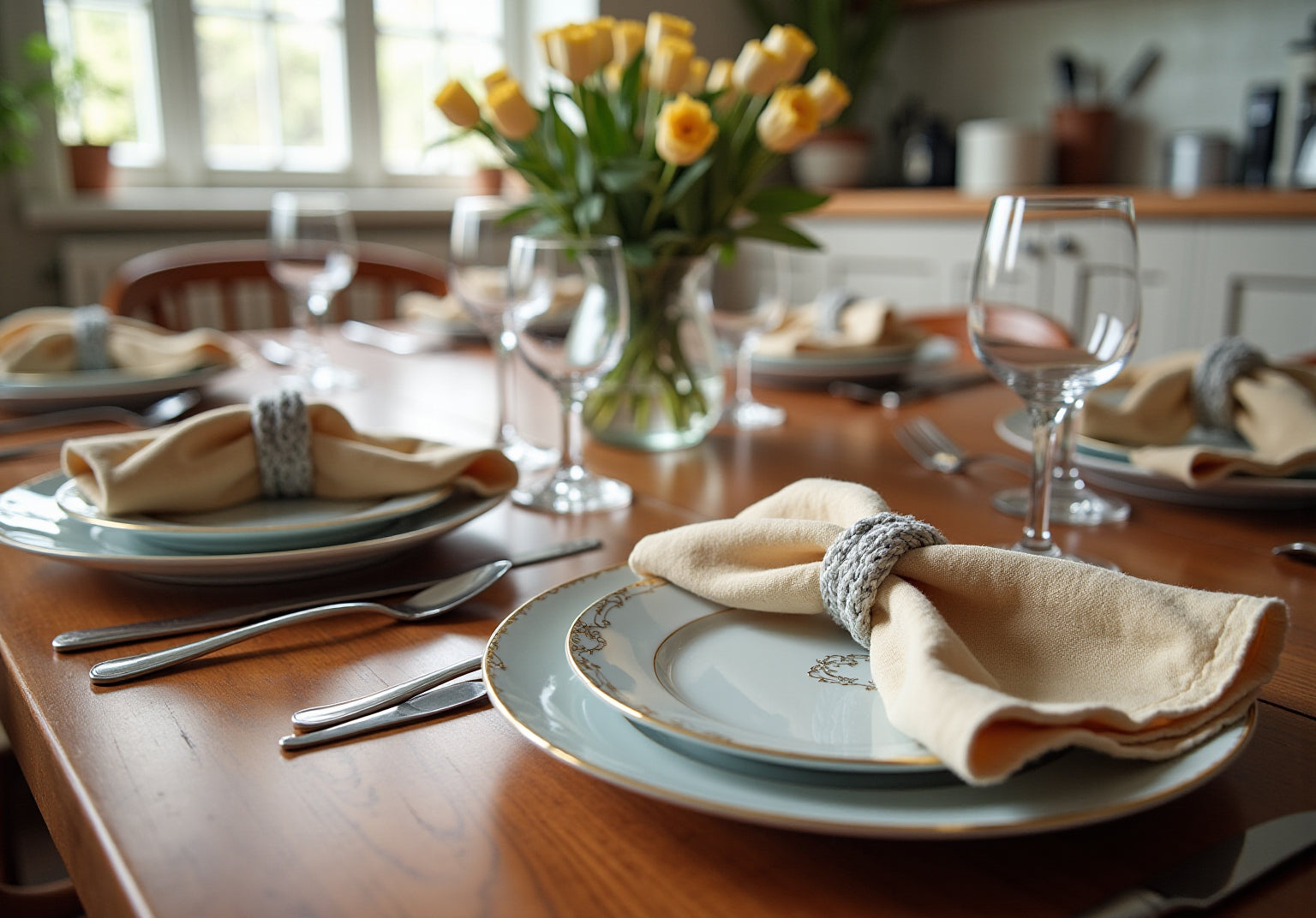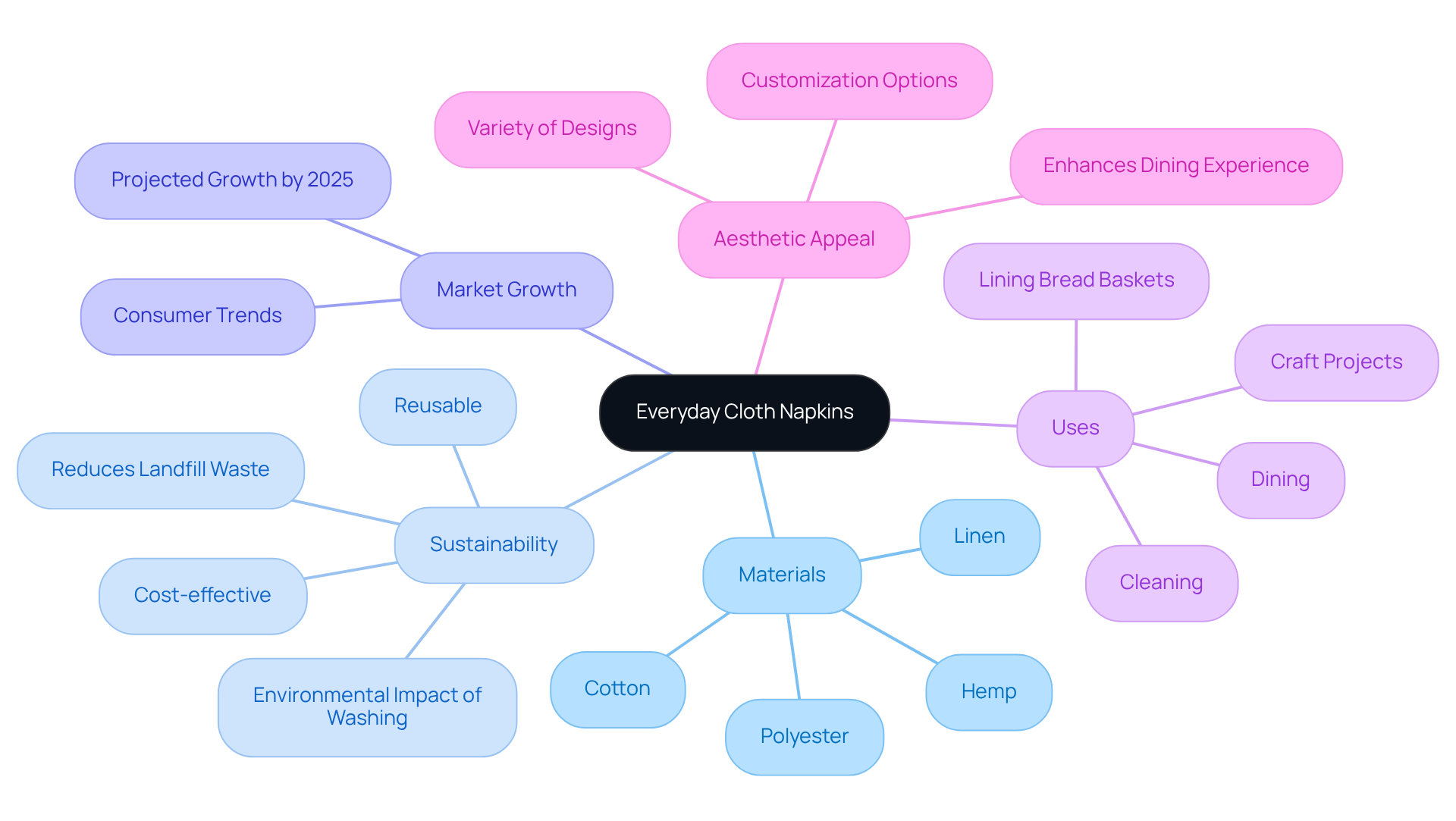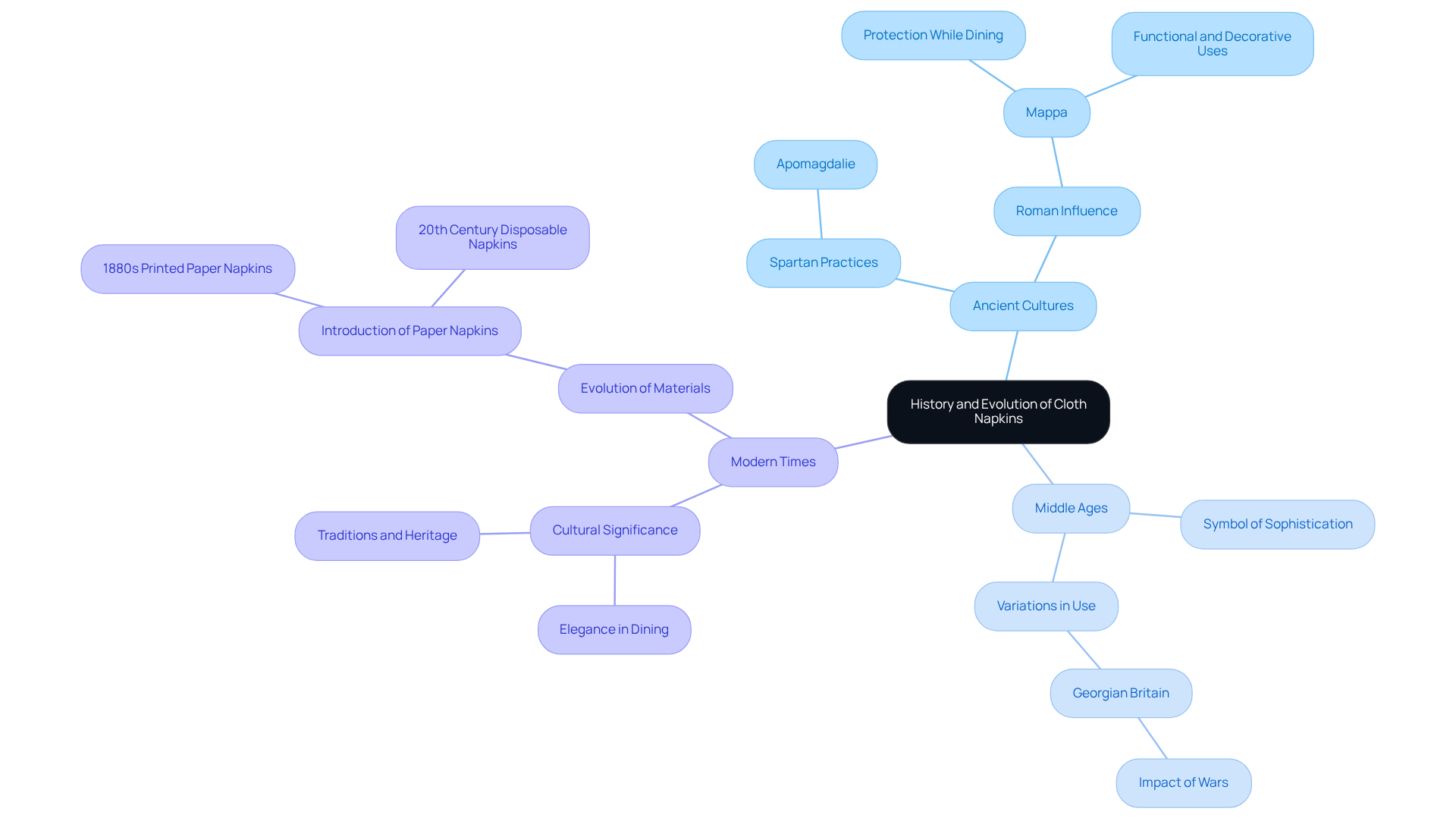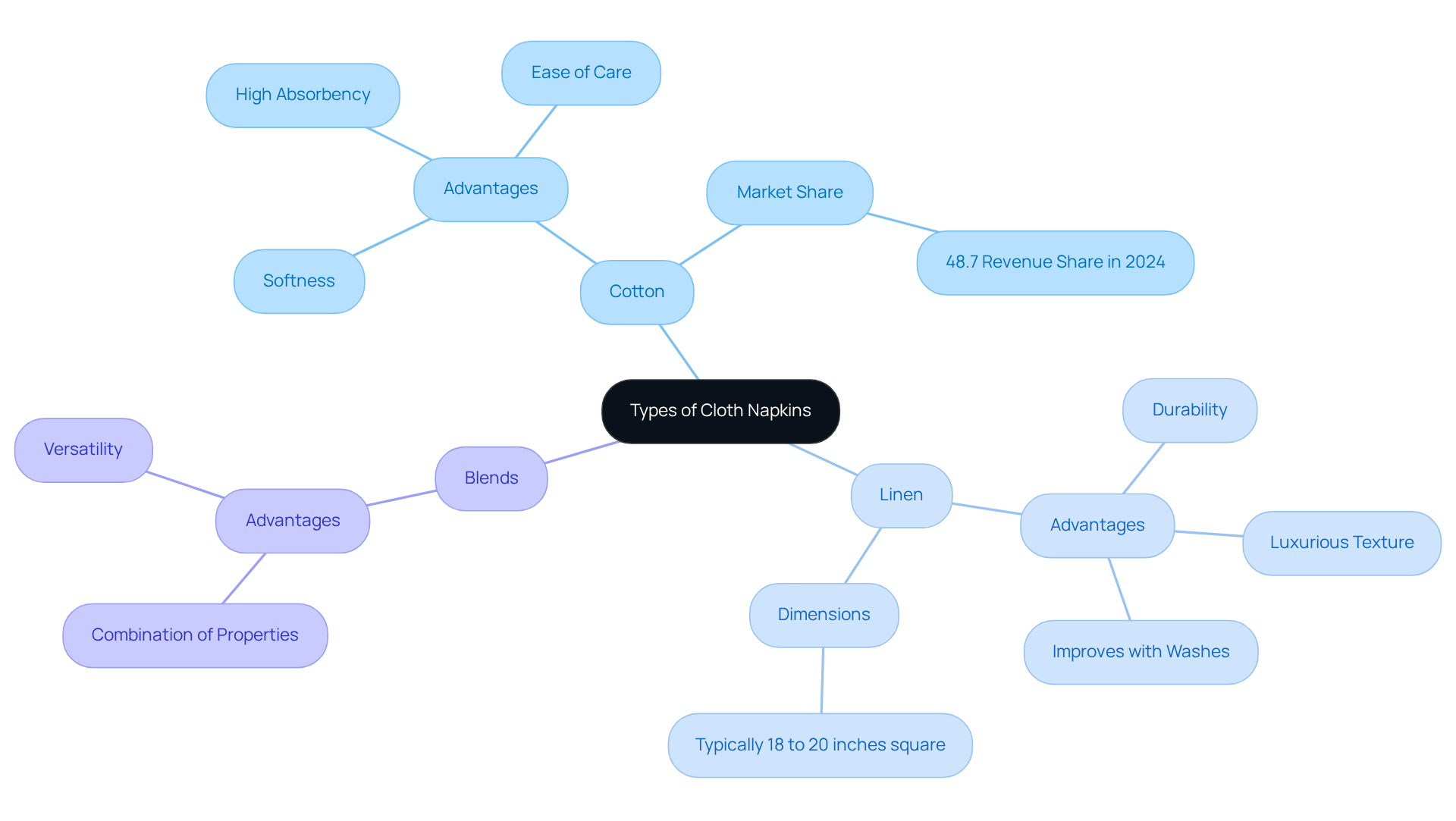
Everyday Cloth Napkins: Definition, Benefits, and History
Overview
Everyday cloth napkins are reusable textile items, typically made from cotton or linen, serving as eco-friendly alternatives to disposable paper napkins. We understand that many are looking for sustainable solutions to reduce waste in their daily lives. These napkins not only contribute to sustainability but also offer cost savings and a way to enhance your dining experiences. Imagine the warmth and charm they can bring to your table, transforming ordinary meals into special moments.
The article highlights the numerous benefits of cloth napkins, tracing their historical significance and evolution across various cultures. You might be wondering how such a simple change can make a difference. By choosing cloth napkins, you’re not just making a practical choice; you’re embracing a tradition that values both the environment and the art of dining.
We’re here to help you create the home you love, one thoughtful choice at a time. Explore the potential of incorporating cloth napkins into your daily routine and experience the joy they can bring to your meals.
Introduction
Everyday cloth napkins embody a sustainable shift in our dining culture, moving us away from disposable paper products that contribute to environmental waste. We understand that making choices for our homes can feel overwhelming, but these reusable textiles not only enhance the aesthetic of any meal but also offer practical benefits that can lead to significant savings over time.
As the popularity of these eco-friendly alternatives rises, you might be wondering about their practicality and the environmental impact of laundering them. What makes everyday cloth napkins a compelling choice for both the eco-conscious consumer and the casual diner? Together, let’s explore the many reasons to embrace this nurturing option.
Define Everyday Cloth Napkins
Everyday cloth napkins are reusable textile items, typically crafted from materials like cotton or linen, designed specifically for meal use. Unlike disposable paper towels—which contribute significantly to landfill waste, with approximately 35% of municipal solid waste being paper—everyday cloth napkins are a durable, washable alternative that can be utilized repeatedly. This makes everyday cloth napkins a sustainable option for those who care about the environment. The market for everyday cloth napkins and fabric table linens is anticipated to grow considerably by 2025, reflecting an increasing consumer inclination towards eco-friendly meal options.
These cloths come in various sizes and patterns, suitable for both casual and formal dining experiences. Their primary function is to provide diners with a means to wipe their hands and mouths while enhancing the aesthetic appeal of the dining experience. Imagine customizing fabric towels for family use; not only are they practical, but they also add a delightful touch to any meal. This customization allows families to monitor their cloths, encouraging diverse uses before laundering and minimizing overall waste.
Incorporating everyday cloth napkins into meal customs promotes sustainability. For instance, everyday cloth napkins can be used multiple times before washing, which not only saves money over time compared to disposable options but also reduces environmental impact. Additionally, fabric pieces can serve various functions beyond dining—such as lining bread baskets or being repurposed as cleaning rags—highlighting their versatility. Experts in home decoration emphasize that using everyday cloth napkins as fabric utensils communicates a sense of occasion, transforming ordinary meals into memorable experiences.
However, we understand that it’s essential to consider the environmental impact of washing fabric serviettes, as this can involve water and energy use. Nonetheless, with proper care, fabric alternatives can last for many years, making them a cost-effective and eco-friendly option. We’re here to help you create the home you love while being mindful of our planet.

Explore the Benefits of Using Cloth Napkins
We understand that choosing the right dining accessories can be a significant decision, especially when considering both the environment and your budget. Utilizing everyday cloth napkins offers numerous benefits, including:
- Ecological sustainability
- Financial savings
- An enhanced dining experience
Unlike paper serviettes, which contribute to landfill waste, using everyday cloth napkins can significantly reduce their environmental impact because they can be laundered and reused.
With proper care, everyday cloth napkins and other fabric dining accessories can last for several years, leading to substantial long-term savings compared to the ongoing costs of disposable paper options. You might be wondering about their practicality—everyday cloth napkins are not only more absorbent but also more durable, making them ideal for those messy meals we all experience from time to time.
Moreover, using everyday cloth napkins can truly elevate your dining experience, adding a touch of elegance and sophistication to any table setting. Many users find that they save money over time, as the cost-per-use of everyday cloth napkins decreases significantly since they can be used multiple times. This not only results in savings but also supports a more eco-friendly lifestyle, as cotton cloths do not contribute to microplastic pollution during laundering, unlike synthetic alternatives.
Overall, making the switch to everyday cloth napkins is a practical choice that balances environmental consciousness with financial benefits. We're here to help you create the home you love, one thoughtful choice at a time.
Trace the History and Evolution of Cloth Napkins
The history of fabric serviettes is truly fascinating, reaching back to ancient cultures. Imagine the Spartans in Greece, who ingeniously used edible dough, known as 'apomagdalie,' to cleanse their hands. This innovative practice laid the groundwork for the Romans, who popularized fabric serviettes, referred to as 'mappa.' The mappa was not just a practical tool; it was a larger fabric that protected while dining in a reclining position, serving both functional and decorative purposes during meals. It beautifully showcases how dining customs have evolved over time.
As time progressed, these simple fabric squares transformed into intricately designed textiles, often adorned with family crests that reflected the social status of their owners. Can you imagine the stories these linens could tell? Table linens were once considered precious items, frequently passed down through generations in wills, highlighting their significance in society until the late 1800s.
By the Middle Ages, fabric serviettes had become essential in European meals, symbolizing sophistication and hospitality. However, the application of cloths varied in Georgian Britain due to wars, particularly conflicts with France. Yet, even today, fabric serviettes continue to embody elegance in dining environments worldwide. They remind us of the rich history and development of table manners, inviting us to appreciate the traditions that shape our dining experiences. We’re here to help you create the home you love, where every meal can reflect this beautiful heritage.

Examine Types and Materials of Cloth Napkins
Cloth serviettes come in a wonderful variety of materials, each offering unique advantages tailored to your dining experiences. You might be wondering which material is best for your needs. The most common options include:
- Cotton
- Linen
- Blends
Cotton cloths are beloved for their softness, high absorbency, and ease of care, making them a practical choice for everyday cloth napkins. In fact, many consider cotton to be the most absorbent fabric for cloth, which is especially beneficial for those meals that are likely to cause spills. It's noteworthy that cotton kitchen textiles represented approximately 48.7% of revenue share in 2024, highlighting their importance in the market.
On the other hand, textile serviettes are recognized for their durability and luxurious texture, making them a favored choice for formal dining environments. They not only enhance the aesthetic appeal of your table but also improve in quality with each wash, ensuring longevity. You’ll be pleased to know that fabric linens are available in various dimensions, typically ranging from 18 to 20 inches square, and come in a multitude of hues and designs. This variety allows for customization, helping you elevate any table setting.
As cooking and baking become cherished hobbies, many consumers are investing in high-quality linens that not only enhance their kitchen experience but also provide durability and ease of use. When choosing everyday cloth napkins, it’s essential to consider factors such as absorbency, durability, and ease of maintenance to ensure they effectively meet your dining needs. Remember, we’re here to help you create the home you love, and finding the right cloth serviettes can make all the difference in your dining experience.

Conclusion
Everyday cloth napkins offer a sustainable and elegant alternative to disposable paper options, beautifully merging functionality with environmental consciousness. By integrating these reusable textiles into your daily dining practices, you not only enhance your meal experiences but also contribute positively to reducing waste and promoting a greener lifestyle.
We understand that making eco-friendly choices can feel overwhelming, but the article highlights the numerous advantages of everyday cloth napkins. Their eco-friendliness, cost-effectiveness, and versatility make them a wise choice. From their historical significance in ancient cultures to their modern-day applications, cloth napkins have evolved into essential dining accessories that elevate any meal. You might be wondering about the best materials to choose; the discussion on fabrics like cotton and linen underscores practical considerations for selecting the right one to suit your personal preferences and needs.
Embracing everyday cloth napkins is more than just a dining choice; it’s a commitment to sustainability and a nod to tradition. By opting for these reusable textiles, you can transform your dining experiences while making a meaningful impact on the environment. We’re here to help you create the home you love, so consider making the switch today and enjoy the blend of practicality and elegance that everyday cloth napkins bring to your table.
Frequently Asked Questions
What are everyday cloth napkins?
Everyday cloth napkins are reusable textile items, typically made from materials like cotton or linen, designed for meal use. They provide a sustainable alternative to disposable paper towels.
How do everyday cloth napkins contribute to sustainability?
Everyday cloth napkins can be used multiple times before washing, reducing waste and environmental impact. They also save money over time compared to disposable options.
What are the benefits of using cloth napkins over paper towels?
Cloth napkins are durable, washable, and can be utilized repeatedly, whereas paper towels contribute significantly to landfill waste. Approximately 35% of municipal solid waste is paper.
Can everyday cloth napkins be customized?
Yes, everyday cloth napkins can be customized for family use, adding a practical and aesthetic touch to meals while allowing families to monitor their cloths and minimize waste.
What additional uses do cloth napkins have?
Besides dining, cloth napkins can be used to line bread baskets or repurposed as cleaning rags, highlighting their versatility.
What is the projected market trend for everyday cloth napkins?
The market for everyday cloth napkins and fabric table linens is anticipated to grow considerably by 2025, reflecting an increasing consumer inclination towards eco-friendly meal options.
What should be considered regarding the environmental impact of washing cloth napkins?
While washing fabric serviettes involves water and energy use, proper care can ensure that fabric alternatives last for many years, making them a cost-effective and eco-friendly option.
